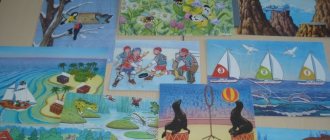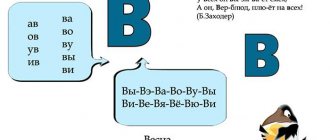Long-term planning of work with children 3-4 years old with general speech underdevelopment of levels 1 and 2
In addition to classes for the development of understanding of speech, active speech, the formation and improvement of the grammatical structure of speech, the development of verbal communication and coherent speech, games, exercises, and classes are conducted for the children of the group to develop auditory attention, phonemic hearing and perception, visual attention and perception, the prosodic aspect of speech , education of general speech skills.
In such classes, children learn to recognize and distinguish non-speech sounds and sound signals consisting of 3-4 words of sounds; a sense of rhythm, auditory-verbal memory, visual memory and attention develops; children develop correct speech diaphragmatic breathing and long speech exhalation; Speech imitation, intonation expressiveness, and rhythm of speech develop.
Throughout the first year of study with children with
OHP 1 and 2 levels, the teacher carries out targeted work on the development of articulatory motor skills, fine motor skills and the psychological basis of speech.
For working with children, complexes have been selected that combine exercises aimed at developing articulatory motor skills, fine movements of fingers, breathing, voice, and the development of the child’s emotional sphere. Complexes are associated with lexical material accessible to children. The game form of teaching the material is most consistent with the psychological capabilities of preschoolers.
Exercises to develop articulatory and fine motor skills are carried out daily so that the motor skills developed by children are consolidated and become stronger. The work takes at least 5 minutes. Articulation exercises are performed in front of a mirror, sitting on a chair, as shown by an adult in stages. The execution of the exercise is also checked step by step.
An important stage of correctional and developmental work in a group is the individual work of the teacher with the child.
Individual work is carried out after subgroup classes and children’s rest. The duration of individual lessons does not exceed 10 minutes. Planning is carried out on the basis of the examination of the child, the recommendations of the State Medical Inspectorate and the psychologist. During the year, two types of individual work planning are used: long-term (for the whole year) and calendar-perspective (for one month). This contributes to more in-depth and high-quality work with each child throughout the school year. Such planning makes it possible to take into account the characteristics of the child’s speech and mental development, consolidate the material covered, and determine the dynamics in development.
It is impossible to talk about the success of correctional and developmental work in a speech therapy group without close contact between the teacher and the parents of preschool children and without their parents’ help. Introductory conversations are held with the parents of the pupils; messages and consultations are offered at the parent corner stands; parents are invited to individual conversations regarding the state of their children’s speech development; are actively involved in the educational and development process.
System for long-term planning of a speech therapist teacher with students with special needs development
The scheduling system contains the following sections of the plan:
Section “Development of general speech skills, articulatory gymnastics, development of fine motor skills.”
To develop general speech skills, various types of work are proposed to overcome violations of the prosodic components of speech - tasks for raising and lowering the tone, accelerating and slowing down the tempo of speech, tasks for reproducing rhythmic structures, placing logical stresses, soft attack of the voice, strength, duration of sound; training in smooth speech exhalation, clarity of diction, intonation.
To develop fine motor skills, children are offered complex movements with elements of self-massage and exercises with various objects. These exercises are aimed at normalizing muscle tone, developing synchronous interaction between movements and speech, memorizing a series of motor acts, and developing fine motor coordination.
Articulatory gymnastics is first given in the form of individual exercises - first of all static, then dynamic, then in groups of sounds, and later, as it is mastered, it is combined into interactive articulatory gymnastics-fairy tale, which allows you to solve several correction problems at once. The sequence and duration of the exercises is determined by the presence or absence of dysarthria, its form and severity.
Section “Development of phonemic representations”
includes tasks for the development of auditory perception, auditory memory, sense of rhythm, and the development of phonemic perception.
Section “Development of mental processes”
contains tasks for the development of auditory and visual attention.
Section “Development of vocabulary and grammatical structure”
addressed primarily to children with general speech underdevelopment for detailed study. Children with phonetic-phonemic underdevelopment of speech should not have difficulties with it. The section contains tasks for the development of active vocabulary and the formation of grammatical structure at the morphological and syntactic levels. The formation of the lexical and grammatical basis of coherent speech is the development and consolidation of skills in constructing sentences of different structures.
Section “Development of coherent speech”
It is mainly planned for children with phonetic-phonemic underdevelopment of speech, but it is also given to children with severe speech impairments in the zone of proximal development, i.e. we give the opportunity, and if the child cannot cope, cannot answer, we offer an answer from another child or adult. The section contains tasks for the development of both dialogic and monologue speech.
Long-term planning of speech therapy work at a speech center
with children 7 years old
I
period (September, October, November)
| Sections of work | Content |
| Development of general speech skills | 1. With children of the second year of study, continue working on the development of speech breathing. 2. With newly admitted children, begin work on developing correct speech breathing. 3. Continue to work on developing correct voice delivery and fluency of speech. 4. Teach children to observe vocal mode, avoiding forcing the voice or screaming. 5. Teach children to arbitrarily change the strength of their voice: speak softer, louder, louder, quieter, whisper. |
| Articulation gymnastics | 1. Develop the mobility of the organs of the articulation apparatus with the help of static and dynamic exercises. 2. Prepare the organs of the articulatory apparatus for the correct pronunciation of sounds. 3. Develop facial muscles. |
| Sound pronunciation | Strengthen the skills of clear pronunciation of sounds already present in children’s speech. Form the correct pronunciation of sounds and begin their automation in newly admitted children. Continue automating the correct pronunciation of speech sounds in children who attended a speech therapy center. |
| Working on the syllable structure of a word | 1. Perception and reproduction of non-speech rhythmic contours (clapping, tapping, speech with movement, etc.). 2. Dividing words into parts (syllables) based on visual cues (chips, cards). 3. Pronunciation of words available by syllabic class. Practice pronouncing polysyllabic words. |
| Development of phonemic representations | 1. Consolidate children’s knowledge of vowels and consonants and their characteristics. Exercise children in distinguishing vowels and consonants, in selecting words for given vowels and consonants. 2. To consolidate ideas about the hardness and softness of consonant sounds. Practice differentiating sounds by hardness and softness. 3. Strengthen the ability to isolate sound from a word. Exercise children in isolating sounds from words. 4. Strengthen the ability to conduct sound analysis and synthesis of words such as wasp, forest. 5. Learn to analyze and synthesize words like mother, elephant, bridge, fox, leaf. |
| Preparing for literacy | Form a correct idea of the difference between sounds and letters. Introduce children to new letters. Exercise children in laying out new letters from sticks and in printing letters. Teach children to print and read syllables and words with new letters. Teach children to solve puzzles and crosswords. 6. Strengthen the ability to transform letters, distinguish between correctly and incorrectly printed letters, and complete unfinished letters. |
| Vocabulary | Systematize children's knowledge about mushrooms, vegetables, fruits, berries, wild animals, autumn, autumn natural phenomena. Introduce children to the periods of autumn (early, golden, late) and the autumn months. Reinforce your knowledge of tree names. Clarify the concepts of “vegetables” and “fruits”. Expand ideas about the work of adults in vegetable gardens, orchards, and fields in the fall. Reinforce knowledge of the names of primary colors and their shades. Systematize children’s ideas about the diversity of migratory and wintering birds. To consolidate and expand children's knowledge about migratory and wintering birds and their behavior in the fall. Expand children's understanding of the diversity of plants in the autumn forest, clarify knowledge about mushrooms and wild berries. Systematize children's ideas about the habitats of wild animals. Expand and deepen your understanding of preparing them for winter. Clarify and expand ideas about autumn clothing, shoes, hats and the materials from which they are made. To form ideas about the work of people in rural areas, about the benefits of their work. Enter nouns, adjectives and verbs on these lexical topics into the active dictionary. Develop vocabulary variability. Contribute to the formation of accuracy of the semantic meaning of words and expressions, including figurative, abstract, etc. Develop understanding and ability to explain the meanings of words based on their semantic structure, activate meaning-forming processes. |
| Development of grammatical structure of speech | 1. Improve children’s ability to form and use singular and plural nouns in speech (topics: “Mushrooms,” Vegetables,” “Fruits,” “Berry. Homemade preparations,” “Autumn, trees, autumn clothes,” “Wild animals” , “Migratory birds”, “Wintering birds”, “Domestic animals and birds and their young”, “Winter. Winter clothing). 2. Continue work on learning to coordinate adjectives with nouns, on the practical use of relative and possessive adjectives in speech on the topics being studied. 3. Strengthen the ability to correctly use simple prepositions in speech, clarify their meaning and begin to develop in children the ability to use complex prepositions iz-aod, due. 4. Clarify children’s understanding of the meanings of verbs with various prefixes (dig, feed, bend, tie, etc.) and begin to teach how to form prefixed verbs, as well as consolidate them in speech 5. Improve the ability to coordinate the numerals two and five with nouns (by topic). 6. Work on correcting agrammatisms in speech. |
| Teaching coherent speech | 1. Develop in children the desire to discuss what they see, talk about their experiences and impressions. 2. Teach children to make sentences based on pictures (by pictures, by a series of pictures). 3. Strengthen the ability to compose descriptive stories about objects based on the material of the lexical topics covered. 4. Learn to ask questions correctly and stimulate the development of cognitive communication. 5. Improve the skill of retelling short texts, develop speech hearing. 6. Improve the skill of writing stories based on pictures (from pictures, from a series of pictures). 7. Work on improving the processes of attention, memory, operations of analysis, synthesis, comparison, generalization and classification. 8. Learn to establish cause-and-effect relationships, develop verbal and logical thinking. |
| Development of spatial, temporal and elementary mathematical concepts | Clarify ideas about spatial relationships expressed by prepositions in, on, under, for, etc. Practice comparing objects by length, width, height, thickness, classifying and combining them according to 3-4 characteristics. Exercise the ability to navigate on a plane and in space. Learn to actively use words up, down, left, right. Clarify and expand ideas about temporary relationships. Introduce the concept of “days of the week” and the names of the days of the week into the active dictionary. Exercise children in the use of various prepositional-case constructions. Learn to accurately select verbs of motion with prefixes of spatial meaning (went in, left, moved, moved away, left). |
II
period (December, January, February)
| Sections of work | Content |
| Development of general non-verbal skills | Continue to work on developing proper speech breathing in children. To improve children's ability to voluntarily change the strength, pitch and timbre of their voice. Improve your voice skills with a soft attack, at a calm pace. Continue to work on clarity of diction and intonation expressiveness of speech. To develop expressive reading skills, developing accuracy, fluency, expressiveness and awareness (based on short poems of the choice of a speech therapist). |
| Articulation gymnastics | Introduce interactive articulation gymnastics-fairy tale. Prepare the organs of the articulatory apparatus for the correct pronunciation of sounds. Develop facial muscles. |
| Sound pronunciation | Continue to work on automating the correct pronunciation of assigned sounds in children. To form the correct pronunciation of sounds in newly admitted children. |
| Improving the syllabic structure of a word | Pronounce words of an accessible speech class. Gradually increase the complexity of classes. |
| Development of phonemic representations | Strengthen in children the ability to select words for a given sound. Exercise children in distinguishing between hard and soft consonants in a series of sounds, syllables, and words. Improve the skill of isolating a given sound from a word. Strengthen the ability to conduct sound analysis and synthesis of words such as dad, table, bush, linden, leaf, cry. Learn to analyze and synthesize words from 5 sounds. Introduce children to new sounds. Exercise children in isolating these sounds from words, in selecting words with these sounds. Improve the skill of sound analysis of words and analysis of sentences without prepositions and with simple prepositions. Exercise children in drawing up graphic diagrams of sentences. |
| Certificate | Improve children's typing and reading skills of syllables and words with mastered letters. Introduce children to new letters. Exercise children in laying out new letters from sticks, in typing, and “drawing” in the air. Continue teaching children how to solve puzzles and crossword puzzles. Improve the ability to transform letters, distinguish between correctly and incorrectly printed letters, complete unfinished letters, read letters superimposed on each other. Strengthen the ability to correctly name the letters of the Russian alphabet. Teach children to print and read syllables, words, sentences with new letters. |
| Vocabulary | Systematize children's knowledge about winter, about winter natural phenomena. Introduce children to the winter months. Strengthen children's knowledge about wintering birds. Expand your understanding of the behavior and habits of crows, tits, bullfinch, waxwing. Explain why birds need to be fed in winter. Expand your understanding of the life of wild animals in winter. Clarify concepts, expand ideas about materials and tools. Strengthen children's ideas about the New Year holiday. Reinforce the knowledge that there are 12 months in a year, that the year begins on January 1. Give an idea of how the New Year is celebrated in different countries. Systematize children’s ideas about transport, form an idea about types of transport, about professions in transport To consolidate and expand children's knowledge about professions, the content of work, and the role of labor mechanization. Foster respect for working people and the need to work. To consolidate and expand children's knowledge about the tools used by representatives of various professions and the actions performed with the help of these tools. Systematize children's ideas about the habitats of domestic animals and wild animals. Expand and deepen your understanding of preparing them for winter. To achieve children's understanding of the role of humans in keeping pets. Enter nouns, adjectives and verbs on these lexical topics into the active dictionary. Explain the figurative meaning of set expressions; explain the meanings of words based on their word-formation structure, activate word-formation processes. |
| Development of grammatical structure of speech | Improve the ability to form and use singular and plural nouns in speech (on the topics: “Human. Parts of the body”, “Transport”, “Professions. Construction”, “Defenders of the Fatherland”, “Seasons. Calendar. Spring”. Introduce children to methods of word formation (on the topic “Materials and Tools”). Continue work on teaching the agreement of adjectives with nouns (on all lexical topics). Teach the correct use of relative and possessive adjectives in speech (on lexical topics: “Pets”, “Pets and birds and their young”, “Winter. Winter clothing”, “Human. Parts of the body”). To consolidate the ability to correctly use simple and complex prepositions in speech (on the topics “Pets”. “Winter. Winter clothes”). Continue to work on learning to form and use verbs with various prefixes in speech; verbs denoting labor actions (for all topics). Work on correcting agrammatisms in children’s speech. |
| Teaching coherent speech | Improve the ability to compose stories about a subject on topics worked on using a collectively drawn up plan (by picture, by pictures, by a series of pictures) Teach children to write stories based on personal experience, to talk about experiences related to what they read or saw. Teach children to understand and interpret words. Work on improving the processes of attention, memory, operations of analysis, synthesis, comparison, generalization and classification. Learn to establish cause-and-effect relationships, develop verbal-logical thinking, and develop speech hearing. |
| Development of spatial, temporal and elementary mathematical concepts | Teach children to reflect the spatial position of objects in speech. Strengthen the ability to express spatial relationships with complex prepositions because of, from under, etc. Teach children to navigate on a sheet of squared paper, use adjectives to the left, to the right, above, below. Reinforce the idea of the sequence of days of the week and months of the year. Fix the names of the days of the week and months of the year in speech. Learn to establish age differences between people. Fix in speech the words wider, narrower, higher, lower, more, less, longer, shorter. Exercise children in the use of various prepositional-case constructions. Learn to accurately select verbs of motion with prefixes of spatial meaning (drove in, left, moved, drove off, left). |
III
period (March, April, May)
| Sections of work | Content |
| Development of general non-verbal skills | Develop correct vocal performance and expressive reading. Continue to work on the tempo and rhythm of speech, clarity of diction, and intonation expressiveness of speech in everyday communication. Improve the sonority and mobility of the voice (quick and easy change in strength, pitch, timbre). |
| Articulation gymnastics | As needed: for children who missed this stage of work, and for children with severe forms of dysarthria. |
| Sound pronunciation | Finish automating all sounds for all children. Differentiate mixed sounds. |
| Improving the syllabic structure of a word | Gradually increase the complexity of spoken words. Pronounce couplets and quatrains |
| Development of phonemic representations | Exercise children in selecting words for a given sound, in distinguishing between hard and soft consonants, in isolating sounds from words. Strengthen the ability to conduct a complete sound analysis of words like weed, plum, mask, bowl, car. Introduce children to new sounds. Exercise children in isolating these sounds from words, in selecting words with these sounds. Form the idea that the letters b and b do not represent sounds. Improve the skill of syllabic analysis of one-, two- and three-syllable words. Learn to divide four-syllable words into syllables. Improve the skill of analyzing simple sentences without prepositions with simple prepositions. Learn to analyze simple sentences with complex prepositions. Exercise children in drawing up graphic diagrams of sentences. Reinforce your knowledge of known spelling rules. |
| Certificate | Strengthen the skill of typing syllables and words. Introduce children to new letters. Exercise children in solving crossword puzzles and solving puzzles. Learn to recognize letters from different fonts, distinguish between correctly and incorrectly printed letters; letters superimposed on each other. Learn the alphabet. Ensure the formation of initial skills in mastering written language. |
| Vocabulary | Summarize children's ideas about typical spring phenomena in living and inanimate nature. Introduce them to the spring months. To give an idea that changes in the natural world are associated with warming and the emergence of necessary conditions for the life of plants and animals. Deepen children's knowledge about Russia. Foster a sense of pride for the Motherland. Deepen and expand children's knowledge about their hometown, about the distinctive features of the city. Foster a sense of pride in your hometown. To reveal and deepen ideas about the changes occurring in living and inanimate nature in late spring. Summarize children's knowledge about the life of migratory birds in late spring (building nests, hatching and feeding chicks, catching insects). Expand and generalize children’s ideas about school, learning, and school supplies. Enter nouns, adjectives and verbs into the active dictionary: on these lexical topics. Develop understanding and explain the figurative meaning of set expressions; explain the meanings of words based on their word-formation structure, activate word-formation processes. |
| Development of grammatical structure of speech | To consolidate the correct use of relative and possessive adjectives in speech (on the topics: “Early signs of spring. Primroses.” “The return of birds. Insects,” “Animals of hot countries”), agreement of adjectives and numerals with nouns (on all topics). Reinforce the correct use of simple and complex prepositions in speech (on the topic “The Return of Birds. Insects”). Learn to coordinate possessive pronouns with nouns (on the topics: “Mom’s Day. Family”, “City. Address”, “School Supplies”). Improve the ability to form comparative forms of adjectives (on the topic “The Return of Birds. Insects”). Work on correcting agrammatisms in children’s speech. |
| Teaching coherent speech | Improve the skills of full and brief retelling, descriptive story, story based on a picture and a series of pictures, story from personal experience. Develop children's individual abilities in creative speech activity. Develop the ability to select the most interesting and significant events and episodes for creative stories, finding the original form of transmission, including descriptions of nature and the surrounding reality in the narrative, using verbal and non-verbal means. Encourage children to make statements and describe what they saw. Work on improving the processes of attention, memory, operations of analysis, synthesis, comparison, generalization and classification. Learn to establish cause-and-effect relationships, develop verbal thinking, and develop speech hearing. Develop dialogical and monologue forms of speech. stimulate children’s own statements. Teach children to understand their experiences and feelings and other people, talk about it |
| Development of spatial, temporal and elementary mathematical concepts | Strengthen ideas about the sequence of days of the week, months, relationships in time (minute - hour, week - month, month - year Practice children in reflecting the spatial position of objects in speech. Practice children's orientation on a sheet of squared paper, using adjectives to the left, to the right, above, . Practice orientation on a plane and in space. Learn to actively use the words top, bottom, left, right. Strengthen ideas about time, introduce words earlier, later into the active dictionary; yesterday and the day before yesterday; tomorrow and the day after tomorrow; older, younger. Exercise children in the use of various prepositional-case constructions. Learn to accurately select verbs of motion with prefixes of spatial meaning (flew in, flew out, flew over, flew away, flew away). |



